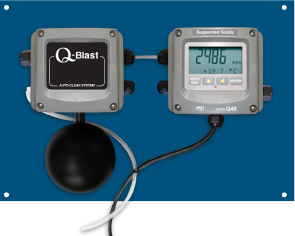- Home
- Products
- Water Measurements
- Analytical Technology Inc.
- Dissolved Solids
- Q46/88 Suspended Solids Monitor
Q46/88 Suspended Solids Monitor
Categories: Analytical Technology Inc., Dissolved Solids, Products, Water Measurements
- General Details
- Features
- Documents
General Details
Monitoring suspended solids in wastewater and industrial process water can be useful for either process control or for alarming of unusual conditions. In biological treatment systems, monitoring suspended solids in the aeration tank can assist operators in maintaining optimum MLSS (Mixed Liquor Suspended Solids) concentration. In industrial clarifier’s, suspended solids water quality monitoring can warn of upset conditions that might result in the discharge of solids that exceed plant permits.
ATI’s Model Q46/88 Suspended Solids Monitor provides real time monitoring of suspended solids in a variety of water and wastewater applications. A submersible sensor immersed in process tanks or effluent channel senses particulates in the water using an optical backscatter technique that allows measurement over a wide range. Results are displayed on the Q46 electronic unit mounted near the sensor with a variety of outputs provided as standard.
SENSOR OPERATION
Suspended solids sensors are optical devices operating in the infrared region. Unlike turbidity sensors that use 90 degree scatter to optimize sensitivity, suspended solids sensors use “backscatter” to allow solids measurements at much higher levels. Operation with infrared light ensures very long sensor life and minimizes the effects of changing sample color. Sensors are designed to withstand the rigorous conditions of wastewater and industrial process streams and to last for years of service with nothing more than occasional cleaning of the sensing surface. There are no protruding surfaces near the sensing element to avoid accumulation of fibrous materials. The sensor is simply pipe mounted using mounting adapters available from ATI.
AUTOMATIC SENSOR CLEANING!
A Blast of Air Keeps the Auto-Clean Sensor Clean!
A Blast of Air Keeps the Auto-Clean Sensor Clean!
Optical sensors used for monitoring biologically active systems such as aeration tanks or aerobic digestors will require periodic cleaning to maintain the integrity of the measurement. Biological slime deposited on the optical surface will degrade the ability to transmit IR light into the sample. The frequency of cleaning varies widely depending on the turbulence in the process. Course bubble diffusion systems tend to scour the sensor while fine bubble diffusion systems result in more rapid sensor fouling.
Cleaning can be done manually by simply wiping the sensor as needed, but ATI also offers an automatic air-blast cleaning system as an option. The “Q-Blast” air cleaning system is controlled by the Q46/88 Suspended Solids Monitor and provides a compact air compressor system that periodically applies pulses of compressed air across the optical surface to remove accumulated biofouling. This system greatly reduces the requirement for manual maintenance, with cleaning frequency programmed to occur as often as necessary.
Features
AC or DC Power Options
Power options include universal 100-240 VAC +/-10%, or 12-24 VDC.
Extra Outputs
Expansion board to add a third 4-20 mA analog output or to add three additional non-isolated low power relays.
Flexibility
Wide range capability, with selectable ranges of 0-2.000, 0-20.00, and 0-200.0 NTU provide maximum application flexibility.
Analog Output Options
Two isolated 4-20 mA outputs are standard, with an option for a third output if required. Default setting provides analog outputs for turbidity and temperature.
PID Output
Standard PID control function assignable to one analog output.
Digital Communications
Communication options for Profibus-DP, Modbus-RTU, Modbus-TCP/IP or Ethernet-IP.
Relay Contacts
Three SPDT relays are standard, with relay functions programmable for alarm, control, or trouble indication. Three additional low power relays available as an option.
Flexible Mounting
NEMA 4X (IP-66) enclosure is suitable for wall, pipe, or panel mounting.
NEMA 4X (IP-66) enclosure is suitable for wall, pipe, or panel mounting.
Clear Display
Back-lit large LCD display provides clear visibility in any lighting condition. A scrolling second line on the display provides additional information and programming prompts.
Back-lit large LCD display provides clear visibility in any lighting condition. A scrolling second line on the display provides additional information and programming prompts.
Sensor Diagnostics
System automatically checks for sensor fouling, “dry cell”, and light source intensity.
System automatically checks for sensor fouling, “dry cell”, and light source intensity.




